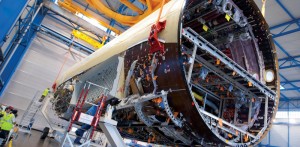
Photo Courtesy of Ainonline.com.
Hexcel is facing a composites material production pinch as its rise in demand for the product is projected to continue at its current pace. Read more below for more information.
Composites material supplier Hexcel is looking for ways to overcome what it sees as a production-capacity challenge from around 2025 if the trend toward more composite materials in airframes continues on its current pace. Should next-generation narrow bodies consist of more than 50 percent carbon-fiber reinforced and other plastics, as in the most recent wide bodies from Boeing and Airbus, the industry will face daunting tasks in cutting manufacturing lead times and costs, said Paul Mackenzie, Hexcel’s v-p for research and technology, at the A-Star Aerospace Technology Leadership forum last month in Singapore.
“For a future narrowbody, the game changes,” he said. The normal monthly production rate for a twin-aisle aircraft averages between 10 and 15. For a single-aisle, rates jump to between 40 and 60. As a consequence, the current hourly lay-down rate, at 20 to 30 pounds, should increase to more than 200 pounds, according to Mackenzie. The cure cycle would have to come down from 8 to 10 hours to 2 to 3 hours.
“Composite processing will not scale without further capital expenditures,” Mackenzie warned. Meanwhile, the recurring cost of composite manufacturing remains twice as high as for metal.
The question of which technology—prepreg (pre-impregnated fibers) and direct resin infusion—will prevail remains unanswered, according to Mackenzie. For the former, lay-down and de-bulking times must come down. He rules out an out-of-autoclave process because porosity of the resulting part would prove too high. For direct resin infusion, cycle time remains an issue.
This article originally posted to Ainonline.com.






